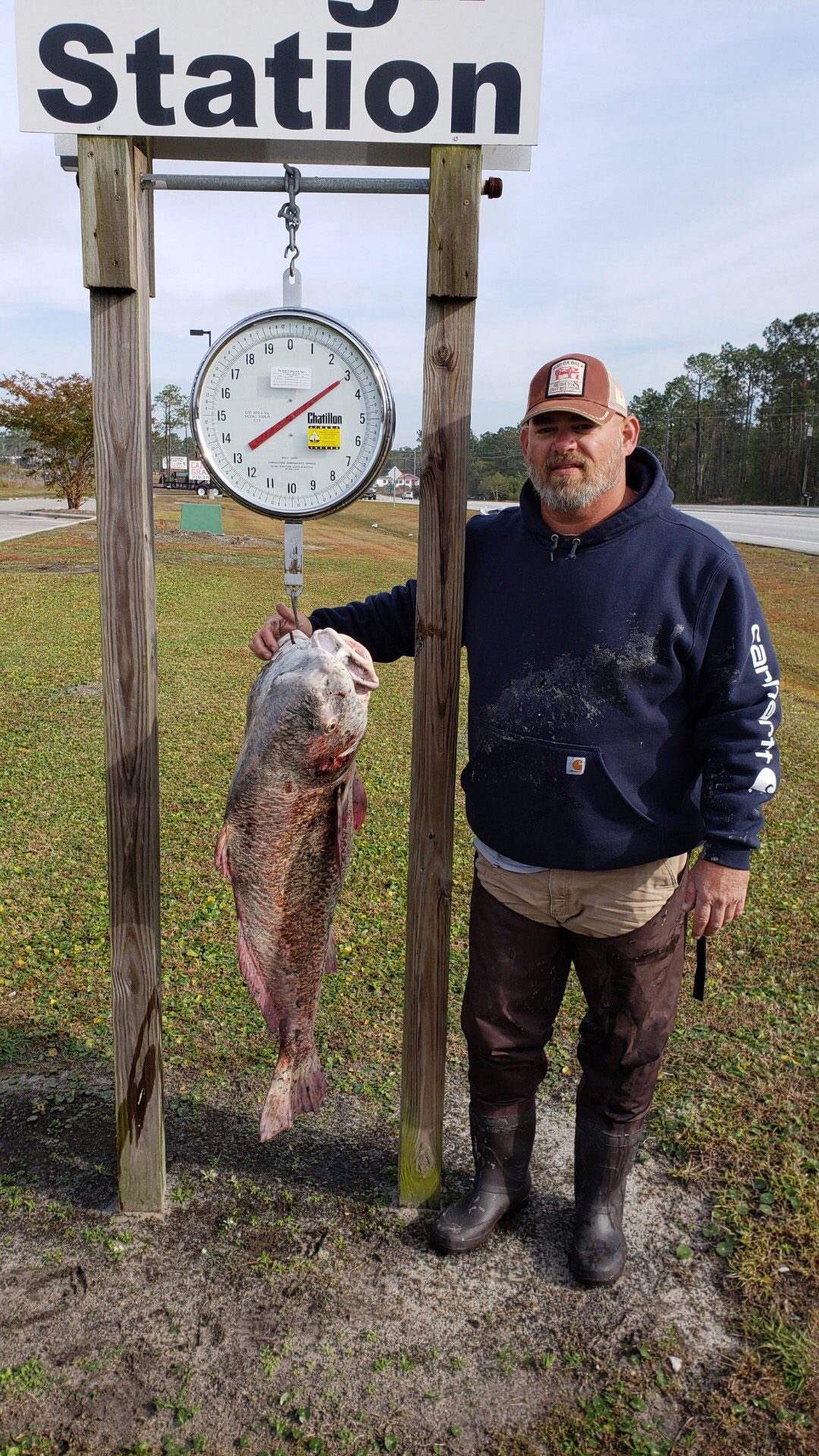Topsail / Sneads Ferry – December 13, 2018
Mike, of Native Son, reports the trout bite is in early winter mode, and as the water continues to cool, remember to fish slow. When in doubt, drop your weight down to the bare minimum and slow down the retrieve even more. MR-17s moved slowly with a just a twitch every now and then should produce bites.
Red drum fishing from December-March is always productive. As the temperature drops, the particulate matter in the creeks begins to settle out, and the resulting clear water is perfect for sight fishing. The smaller pods of fish will start to form larger schools, so you must cover ground to find them. When you do, casting to fish you see is the most exciting thing you can do inshore. Look for the reds in slow moving water that has had time to warm in the sun. Darker bottoms and oyster shells are great places to check, too. Lightweight plastics are the key to drawing strikes.
If the wind cooperates, trips out of the inlets are always fun in the winter. Black sea bass and tautog will be hanging around on nearshore structure, where 2 oz. bucktails tipped with shrimp should draw strikes.

Ray Motsinger, of Hampstead, NC, posing next to his 47″, 63 lb. citation black drum that fell for a bloodworm in the surf at Topsail Beach.
Chadwick, of South End Anglers, reports that speckled trout fishing has been excellent around Topsail Island, with good numbers of fish all throughout the marsh. Find a place with tidal movement and 5’+ of water, and there is a good chance that there will be trout swimming there. MirrOlure MR-17s and 18s, and Z-Man Trout Tricks, MinnowZ, and StreakZ on Fathom Inshore jig heads should put you on the fish. There are a lot of undersized fish around, so keep moving if that’s all you’re finding.
The trout will school in a variety of areas during the winter months. Boat basins, canals, mainland creeks, and docks out of heavy current are all great places to look. Long, light leaders and 1/8 oz. Fathom Inshore jigs are great tools for catching cold water specks. Fish during the middle of the day to allow the water to warm slightly, and cast smaller presentations and lighter leaders while slowing your retrieve down when the water temperature is below 55 degrees.
There are still a few flounder and red drum around in the marsh, most of which have been undersized. Bett’s Halo Shad retrieved slowly along the bottom has been effective for both species.
Black drum will be readily available during the winter months. Fresh cut shrimp on 2/0 to 3/0 circle hooks fished on the bottom will catch them around docks, in marinas and canals, and near bulkheads and bridges.
The reds will be in the same areas, but they will have mostly moved into the surf zone. When conditions allow, large schools of redfish can be sight casted to along the beach front. Z-Man MinnowZ and JerkshadZ rigged on Fathom Inshore jigs are very effective, especially when combined with Pro-Cure.
Sea bass (and tautog) will provide good action throughout the winter on nearshore structure. ARs, hard bottom, and ledges will hold concentrations of sea bass all winter long, and squid baits will regularly produce.
Ray, of Spring Tide Guide Service, reports that the main late-season target has been trout in the river. There have been many big fish caught, but a lot of spikes and 14-15” fish are coming in as well. On some days, hard baits (such as MR-17s and X-Raps) have been drawing the most strikes, while on other days soft plastics like Storm shrimp and Saltwater Assassins have been the better producers. Any color with chartreuse in it works well. A lot of the fish have been in the deeper water since the temperature dropped, so get your bait to the bottom and wiggle it a little bit.
Through the winter, anglers can expect red drum to be schooled up off the shoals on the beach. Trout fishing will be good inshore on the warmer winter days. Look for a soft mud bottom that holds the sun’s heat, as the fish will be drawn to those warmer temperatures.
Marc, of Bad Habit Sportfishing, reports that king mackerel, false albacore, and both bluefin and blackfin tuna have been the target inside the break, where live bait, hard baits, and ballyhoo behind your favorite lure have all been producing.
Bottom fishing has been productive as well. Grouper and jumbo black sea bass have been biting from 65’ out to the break, and they’ve been eating anything thrown at them.
Sea bass and triggers will be around all winter, as will offshore wahoo. When you see a good weather pattern coming, follow the temperature breaks. All you need is a hard break over good bottom for a day or two, and then it’s time to head out to target the ‘hoos.

Kenan Brinson (age 6) showing off the speckled trout that was part of his inshore slam. Brinson also landed a redfish and a flounder while fishing with a Betts Halo Shad around Topsail Island with his dad, Dan.
Jim, of Plan 9 Charters, reports that there is a good mixed bag of nearshore fish being caught in the 5-10 mile range, with bluefish, some false albacore, and black sea bass making up the majority of the catch. King mackerel have been in the 25-30 mile range, where dead bait is working the best.
Over the coming months, expect the kings to be congregated around the Tower area as long as the water temperature is 65 degrees or above.
Bottom fishing has been good for grouper, snapper, and sea bass on cut bait, especially in 70-110’ of water. The bite should stay steady throughout the winter, where the 20-35 mile range is typically the best place to look. Expect sea bass and grunts to be plentiful come January.
The winter is also a great time to head inshore and look for stripers, drum, and trout in the river. White and chartreuse grubs, sassy shad, and paddle tails all work really well for these species in the colder months.
Seaview Fishing Pier is closed for repairs.
Chris, of Surf City Pier, reports that fishing has slowed due to a mixture of dirty water and rough wind, and nothing more than some small trout, mullet, and a few keeper drum have made up the majority of the pier’s catch over the last few weeks. Shrimp and grubs have been the best baits.
During these colder months, the trout, drum, and puffer bite should stay strong, and when the weather starts to warm, bluefish and spanish mackerel will be moving back in.
Elizabeth, of Jolly Roger Pier, reports that mullet, trout, keeper red drum, black drum, bluefish, puppy drum, and puffers are all biting on either live or cut shrimp.
The fishing forecast for the winter months is more speckled trout and drum.





